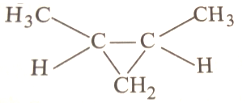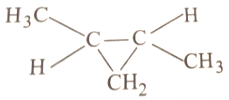Consider the following statements:
(i) Alkene is more reactive than alkyne for electrophilic addition reaction.
(ii) Alkyne gives nucleophilic as well as electrophilic addition reaction.
(iii) Alkyne is more reactive than alkene for nucleophilic addition reaction.
(iv) For electrophilic addition reaction, RI of alkyne is alkyl carbonation.
Of these, correct statements are:
(1) only (i)
(2) (i) and (ii)
(3) (i), (ii) and (iv)
(4) (i), (ii) and (iii)
In the given reaction

The product will be:
1. 
2. 
3. Mixture of 1 and 2
4.
Which compound is least reactive for nucleophilic addition reaction?
(1)
(2)
(3)
(4)
Arrange the reactivity of given carbonyl compounds in decreasing order for addition reaction:
(i)
(ii)
(iii)
(iv)
Select the correct answer from the codes given below:
Codes:
(1) (iv), (iii), (ii), (i)
(2) (ii), (i), (iii), (iv)
(3) (ii), (i), (iv), (iii)
(4) (i), (ii), (iii), (iv)
Arrange the reactivity of the given compounds in decreasing order for addition followed by elimination reaction:
(i) p-Cl
(ii) p-Br
(iii) p-F
(iv) p-I
Select the correct answer from the codes given below:
Codes:
(1) (i), (iii), (ii), (iv)
(2) (i), (iii), (iv), (ii)
(3) (iii), (i), (iv), (ii)
(4) (iii), (i), (ii), (iv)
Which compound will form Schiff base with carbonyl compounds?
(1) p-amines
(2) sec-amines
(3) bydroxylamine
(4) Hydrazine
Gem di-ether is obtained by:
(i) aldehyde, alcohol,
(ii) ketone, alcohol,
(iii) ketone, alcohol, O
(iv) aldehyde, alcohol, O
Select the correct answer from the codes given below:
Codes:
(1) (i), (ii), (iii) and (iv)
(2) (i), (ii) and (iv)
(3) (iii) and (iv)
(4) (i) and (ii)
Which among the following compounds will give addition reaction with water?
(i)
(ii)
(iii)
(iv)
Select the correct answer from the codes given below:
Codes:
(1) (i), (ii), (iii)
(2) (i) and (ii)
(3) (i), (ii), (iv)
(4) only (iii)
Which among the following compounds is used for protection of carbonyl groups?
1. HCN
2.
3. ![]()
4.
In the given reaction,
(A) and (B) respectively are:
(1)
(2)
(3)
(4)






